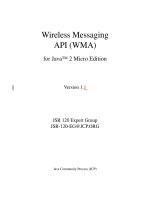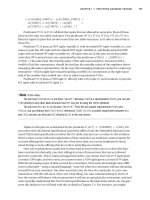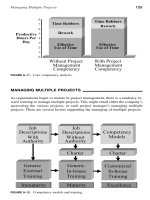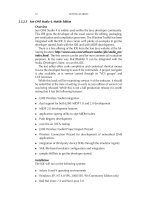Programming java 2 micro edition for symbian os phần 6 ppt
Bạn đang xem bản rút gọn của tài liệu. Xem và tải ngay bản đầy đủ của tài liệu tại đây (589.4 KB, 50 trang )
222 JAVA APIs FOR BLUETOOTH WIRELESS TECHNOLOGY
4.3.4 Connecting to a Service
Once we have obtained the service record relating to our required
service we have everything we need to connect to the service. We
use the getConnectionURL() method of the ServiceRecord to
obtain a String encapsulating the necessary information (protocol,
Bluetooth address of device providing the service, RFCOMM server
channel identifier, etc.) to connect to the service.
public String getConnectionURL(int requiredSecurity, boolean mustBeMaster)
The requiredSecurity argument specifies the level of security
for the connection and can have one of three values defined in Ser-
viceRecord:
public static final int NOAUTHENTICATE_NOENCRYPT
public static final int AUTHENTICATE_NOENCRYPT
public static final int AUTHENTICATE_ENCRYPT
The mustBeMaster argument indicates whether the local device
must be master in connections to this service. If false the local device
is willing to be master or slave in the relationship. The master–slave
role relates to the frequency hopping pattern used in RF communications
between two Bluetooth devices. The master device initiates the connec-
tion and determines the frequency hopping pattern used. The slaves hop
in unison to the master’s pattern. The role (master or slave) that a device
assumes relates to low-level communication and is generally irrelevant to
higher level protocols. The current implementation of JSR 82 on Symbian
OS supports only a value of false for the mustBeMaster parameter
(true will result in an exception being thrown by the open() method).
Once we have the connection URL we use it to open a Connection.
In the case of connections using the SPP, the returned object is cast as a
StreamConnection, as shown below.
String url =
serviceRecord.getConnectionURL(ServiceRecord. NOAUTHENTICATE_NOENCRYPT,
false);
StreamConnection conn = (StreamConnection)Connector.open(url);
OutputStream output = conn.openOutputStream();
4.3.5 Connecting to a Service: the Quick and Dirty Way
In the previous section we described how to access services robustly.
We do a device enquiry then search the returned devices for the
PROGRAMMING THE BLUETOOTH APIs 223
required services and, if found, open a connection using the returned
ServiceRecord.
There is an alternative, quicker way of connecting to a service using
the selectService() method of the DiscoveryAgent class:
public String selectService(UUID uuid, int security, boolean master)
This method simply takes the UUID of the service required; an int
indicating the level of security for the connection; and the master/slave
boolean indicator. The method will search for the service denoted by
the UUID on any devices in range. If the service is found, a String
representing the URL to be used to connect to the service via the
open() method is returned. If no service is found a value of null is
returned.
Note that when using this method it is not necessary to implement a
DiscoveryListener. Nor does it require a RemoteDevice object to
be specified. It simply searches all devices in the vicinity and, if one of
them offers the required service, returns a connection URL. If there are
many devices in the area offering the required service, a connection URL
may be returned to any one of them (it is not possible to specify which).
For these reasons, plus the fact that this method takes only a single UUID,
it is best used to search for specific UUIDs created to denote a specific
service (rather than pre-defined UUIDs representing generic services such
as the SPP, which may be offered by many devices).
4.3.6 Retrieving a Cached Device
Before we leave this section we should discuss one other relevant method
provided by the Java APIs for Bluetooth Wireless Technology. This is the
retrieveDevices() method of the DiscoveryAgent class:
public RemoteDevice[] retrieveDevices(int option)
This takes an integer option argument that can have one of two
values pre-defined in the DiscoveryAgent class:
public static final int CACHED
public static final int PREKNOWN
• CACHED means that the method will return an array of RemoteDe-
vices that have been discovered by previous inquiries and cached
by the implementation; if no devices have been cached, a null value
will be returned
224 JAVA APIs FOR BLUETOOTH WIRELESS TECHNOLOGY
• PREKNOWN indicates a higher level of intimacy, referring to devices
that the local device communicates with often (‘‘paired devices’’); the
current implementation of JSR 82 on Symbian OS does not support
the PREKNOWN option, so a call to retrieveDevices using the
PREKNOWN option will return null.
The retrieveDevices() method will block the current thread until it
returns; it should generally be launched in a new Thread.
4.4 L2CAP Protocol
4.4.1 Introduction
The discussion in the previous sections used Serial Port profile connec-
tions running over RFCOMM to illustrate opening connections. In this
section we shall look at the other connection protocol currently offered
by Symbian OS, L2CAP.
RFCOMM is a higher-level protocol that runs on top of L2CAP.
Unlike SPP over RFCOMM, which is a stream-based protocol, L2CAP
is packet-based. This makes it more suitable for certain types of non-
stream communication, particularly those that route individual packets
to different destinations, methods or classes. In addition, a lower level,
datagram-like protocol such as L2CAP can confer performance advan-
tages over RFCOMM by avoiding the latency and overheads involved in
establishing and maintaining a stream connection.
4.4.2 Maximum Transmission Unit
Remember that L2CAP is a packet-based protocol. The maximum trans-
mission unit (MTU) is the maximum size of a packet of data that can
be sent over the L2CAP link. By default this size is set to 672 bytes.
However, the Java API does give us the option to specify different values
as part of the connection URL passed into the open() method (as will
seen in later sections). MTUs can be specified for transmitting and receiv-
ing data. Specifying MTU values when opening a connection does not
mean that communication (whether sending or receiving) will take place
at that value. Instead, when a connection between a client and server
is opened, a negotiation takes place to agree on acceptable MTUs for
communications in both directions. The agreed MTU will be the lowest
common denominator value that both parties can handle. For instance, if
a server can transmit a packet size of 4096 bytes but the client can only
L2CAP PROTOCOL 225
receive a maximum packet size of 512 bytes, then the negotiated MTU
will be 512 bytes.
It is possible to find out the maximum ReceiveMTU that the local
device will support using the following code:
localDevice.getProperty(“bluetooth.l2cap.receiveMTU.max”);
On Symbian OS Version 7.0s, the maximum values for TransmitMTU
and ReceiveMTU are both 672 bytes (the default values). We can also
find out the negotiated values for ReceiveMTU and TransmitMTU using
the following methods of L2CAPConnection:
public int getTransmitMTU()
public int getReceiveMTU()
For a more detailed discussion of MTUs see the JSR 82 specification.
4.4.3 Setting up an L2CAP Server
Setting up a server for L2CAP is very similar to our earlier example using
the SPP, except that an L2CAPConnection is opened in response to
incoming client requests.
L2CAPConnectionNotifier notifier =
(L2CAPConnectionNotifier)Connector.open(url);
L2CAPConnection conn = notifier.acceptAndOpen();
Here url may have the following form:
“btl2cap://localhost:00112233445566778899AABBCCDDEEFF;name=l2capServer”
The name=l2capServer field is optional. Other optional
fields include ReceiveMTU and TransmitMTU (see the JSR 82 specifi-
cation for a full list of options). The open() method returns an instance
of L2CAPConnectionNotifier. Calling the acceptAndOpen()
method on the L2CAPConnectionNotifierobject indicates the server
is ready to accept client connections. It also adds the ServiceRecord
to the SDDB. The acceptAndOpen() method blocks until the server
accepts a connection request, returning an L2CAPConnection object
enabling communication to take place.
226 JAVA APIs FOR BLUETOOTH WIRELESS TECHNOLOGY
4.4.4 Establishing a Client Connection
To obtain a connection to an L2CAP server, the process is very similar
to that presented in earlier discussions using RFCOMM. We can use a
ServiceRecord obtained by a service search to get the connection
URL via the getConnectionURL() method. We then use this in the
open() method to obtain an L2CAPConnection, as shown below.
String url =
serviceRecord.getConnectionURL(ServiceRecord.NOAUTHENTICATE_NOENCRYPT,
false);
L2CAPConnection conn = (L2CAPConnection)Connector.open(url);
The url will have the general form:
“btl2cap://0050CD00321B:1001;ReceiveMTU=512;TransmitMTU=512”
Where 0050CD00321B is the Bluetooth address of the server and 1001
is the Protocol Service Multiplexor value for the service which identifies
the L2CAP service running on the device and allows the client to connect
to the service.
Again, there are various possible options for the url (check out the
JSR 82 specification for more details). Note that if we wish to change the
ReceiveMTU or TransmitMTU we would have to edit the connection
URL before passing it to the open() method.
Once we have obtained an L2CAPConnection we send a packet
using the send() method, where byte[] data contains the packet to
be sent:
public void send(byte[] data)
The size of data can have any value. However, if it exceeds the value of
TransmitMTU, any additional data will be discarded.
To read a packet of data from an L2CAPConnection we call:
public int receive(byte[] inBuf)
The packet will be read into the inBuf byte array. The size of
inBuf should at least be equal to ReceiveMTU to avoid loss of data.
L2CAPConnection also provides the ready() method:
public boolean ready()
If ready() returns true, a packet of data is available to be received
and we can call receive without blocking.
SECURITY 227
4.5 Security
Security is an important aspect of Bluetooth communication. JSR 82
provides various security options to prevent unauthorized access to a
Bluetooth device and to provide secure communication between devices
using data encryption.
4.5.1 Authentication
Authentication refers to the process of verifying the identity of a remote
device. The authentication mechanism in Bluetooth is based on a PIN
number shared between devices.
A Bluetooth server can require client authentication by adding the
optional authenticate=true parameter to the connection URL, as
shown below.
String url =
“btspp://localhost:00001111222233334444555566667777;authenticate=true”
StreamConnectionNotifier service =
(StreamConnectionNotifier)Connector.open(url);
Similarly, clients can request server authentication in the connec-
tion URL. In the absence of the authenticate=true parameter,
either client or server can, at any time after establishing an connec-
tion, request remote device authentication via the authenticate()
method of RemoteDevice.
On Symbian OS, if authentication of a remote device is requested
the system will display a pop-up dialog on the local device requesting
the user to enter a PIN number (see Figure 4.5) that is shared with the
Figure 4.5 Bluetooth authentication on the Nokia 6600.
228 JAVA APIs FOR BLUETOOTH WIRELESS TECHNOLOGY
user of the remote device. The remote device will prompt its user for the
shared PIN, and only if the PIN codes on both devices match will the
authentication process succeed. Note that the PIN number itself is not
transmitted between devices, instead a 128-bit key derived from the PIN
number is used.
A device may determine if a remote device has been authenticated
by invoking the isAuthenticated() method of RemoteDevice.A
return value of true indicates that the remote device has previously been
authenticated. Note that authentication is not specific to a particular con-
nection. The remote device may have been authenticated by a previous
connection or even another application.
4.5.2 Authorization
Bluetooth authorization is the process by which a server device grants a
specific client access to a specific service it offers. A server can require that
clients be authorized by adding the authorize=true parameter to the
connection URL. Note that authorization also requires authentication so
some parameter combinations (e.g. authenticate=false;autho-
rize=true) are forbidden and will result in a BluetoothConnec-
tionException.
If authorization was not requested in the connection URL, the server
can request client authorization via the authorize() method of the
RemoteDevice.
On Symbian OS, dynamic authorization is granted to a specific remote
device by the user for each connection request. A dialog box prompts the
user to accept or reject the connection (see Figure 4.6).
In addition, current Symbian OS devices allow static authorization by
the user of a paired remote device via the system Bluetooth control panel
Figure 4.6 Bluetooth authorization on the Nokia 6600.
JAVA BLUETOOTH API AND THE MIDP 2.0 SECURITY MODEL 229
(the BCC, in JSR terminology). The remote device becomes trusted and all
incoming connections from it are authorized until the static authorization
is revoked via the Bluetooth control panel.
A server device can determine if a remote device has previously
been authorized by invoking the isAuthorized() method of the Re-
moteDevice. A return value of true indicates the server side connection
to the remote device has been authorized.
4.5.3 Encryption
Encryption is used in Bluetooth communication to protect sensitive data
from eavesdropping. Either client or server can require that a connection
is encrypted by adding the encrypt=true parameter to the connec-
tion URL. Note that encryption requires the previous authentication
of the remote device so some parameter combinations (e.g. authen-
ticate=false;encrypt=true) are forbidden and will result in a
BluetoothConnectionException.
After establishing an unencrypted connection, it is possible to require
further communication to be encrypted by using the encrypt() method
of the RemoteDevice. Encryption is performed transparently by the
implementation using a symmetric encryption algorithm.
A device can determine whether communication with a remote device
is currently encrypted by invoking the isEncrypted() method of the
RemoteDevice. A return value of true indicates that data exchange
with the remote device is encrypted. Note that encryption of the data link
with a remote device is not specific to a particular connection and may
have enabled by a previous connection or even application.
4.6 Java Bluetooth API and the MIDP 2.0 Security Model
A signed MIDlet suite which contains MIDlets that open Bluetooth
connections must explicitly request the appropriate permission in its
MIDlet-Permissions attribute. To make outgoing (client) connections
the MIDlet suite must request the javax.microedition.io.Con-
nector.bluetooth.client permission. To accept incoming (server)
connections the MIDlet suite must request the javax.microedition.
io.Connector.bluetooth.server permission. For example, the
MIDlet-Permissions attribute entry in the JAD file may be as follows.
MIDlet-Permissions: javax.microedition.io.Connector.bluetooth.client,
javax.microedition.io.Connector.bluetooth.server
If the protection domain to which the signed MIDlet suite would be
bound grants, or potentially grants, the requested permissions, the MIDlet
suite can be installed and the MIDlets it contains will be able to open
230 JAVA APIs FOR BLUETOOTH WIRELESS TECHNOLOGY
Bluetooth client and server connections, either automatically or with
explicit user permission, depending upon the security policy in effect.
The Bluetooth protected APIs form part of the Local Connectivity
function group as defined in the
Recommended Security Policy for
GSM/UMTS Compliant Devices
addendum to the MIDP 2.0 specification.
The Sony Ericsson P900/P908 supports the trusted protection domain (on
Organiser firmware versions R2B02 or later). The security policy in effect
for MIDlets in MIDlet suites bound to the trusted protection domain on the
P900/P908 allows automatic access to the Local Connectivity function
group. At the time of writing, the available firmware release (3.42.1)
on the Nokia 6600 only supports the untrusted domain, although future
releases will add support for trusted protection domains.
Whether MIDlets in untrusted MIDlet suites can open Bluetooth con-
nections depends on the security policy relating to the Local Connectivity
function group for the untrusted domain in force on the device. On the
Nokia 6600 and the Sony Ericsson P900/P908, untrusted MIDlets can
access these APIs with User permission, the default being session. On the
Nokia 6600, the user can change the default setting for this function group
to
Blanket
(every invocation succeeds) or to disallow access altogether.
4.7 Sample Code
In this section we shall consider a small peer-to-peer application that
transmits an image between two Bluetooth devices using the Serial Port
profile over RFCOMM. First we consider a MIDlet that offers a service
to receive and display an image. The classes making up the BT Demo
Server MIDlet are depicted in Figure 4.7.
BTDemoServer ImageCanvas
Figure 4.7 A UML class diagram of the BT Demo Server MIDlet.
The BTDemoServer code is listed below.
import javax.microedition.midlet.*;
import javax.microedition.lcdui.*;
import javax.microedition.io.*;
import javax.bluetooth.*;
import java.io.*;
public class BTDemoServer extends MIDlet implements CommandListener,
Runnable {
private static final int IMAGE_SIZE = 11222;
private ImageCanvas canvas;
SAMPLE CODE 231
private Display display;
private Form displayForm;
private StringItem status = new StringItem("status: ", "Off");
private Command exitCommand = new Command("Exit", Command.EXIT, 1);
private Command startCommand = new Command("Start", Command.SCREEN,
1);
private Command stopCommand = new Command("Stop", Command.SCREEN, 1);
private Command clearCommand = new Command("Clear", Command.SCREEN,
1);
private final String uuid = "00112233445566778899AABBCCDDEEFF";
private LocalDevice device;
private byte[] data;
private boolean running = false;
private StreamConnection conn;
public BTDemoServer() {
data = new byte[IMAGE_SIZE];
display = Display.getDisplay(this);
}
public void commandAction(Command c, Displayable d) {
if (c == exitCommand) {
destroyApp(true);
notifyDestroyed();
} else if (c == startCommand) {
running = true;
startServer();
displayForm.removeCommand(startCommand);
displayForm.removeCommand(exitCommand);
displayForm.addCommand(stopCommand);
status.setText("listening");
} else if (c == stopCommand) {
running = false;
displayForm.addCommand(exitCommand);
displayForm.addCommand(startCommand);
displayForm.removeCommand(stopCommand);
status.setText("Off");
} else if (c == clearCommand) {
display.setCurrent(displayForm);
canvas.removeCommand(clearCommand);
canvas.setCommandListener(null);
canvas = null;
}
}
public void startApp() {
displayForm = new Form("Bluetooth Server");
displayForm.setCommandListener(this);
displayForm.addCommand(exitCommand);
displayForm.addCommand(startCommand);
display.setCurrent(displayForm);
displayForm.append(status);
}
public void startServer() {
try {
device = LocalDevice.getLocalDevice();
232 JAVA APIs FOR BLUETOOTH WIRELESS TECHNOLOGY
device.setDiscoverable(DiscoveryAgent.GIAC);
Thread btServer = new Thread(this);
btServer.start();
} catch(BluetoothStateException bse) {
status.setText("BSException: " + bse.toString());
}
}
public void run() {
try {
StreamConnectionNotifier notifier =
(StreamConnectionNotifier)Connector.open("btspp://localhost:"
+ uuid + ";name=serialconn");
ServiceRecord record = device.getRecord(notifier);
record.setDeviceServiceClasses(0x40000);//SERVICE_RENDERING
while (running) {
conn = notifier.acceptAndOpen();
//record is saved to the SDDB on this call
DataInputStream input = conn.openDataInputStream();
input.readFully(data);
input.close();
DataOutputStream output = conn.openDataOutputStream();
output.writeInt(-1);
output.flush();
output.close();
conn.close();
conn = null;
Image image = Image.createImage(data, 0, IMAGE_SIZE);
canvas = new ImageCanvas(image);
canvas.addCommand(clearCommand);
canvas.setCommandListener(this);
display.setCurrent(canvas);
}
} catch(IOException ioe) {
status.setText("IOException " + ioe.toString());
} catch(Exception e) {
status.setText("Exception: " + e.toString());
}
}
public void destroyApp(boolean unconditionally) {
try{
if(conn != null)
conn.close();
}catch(IOException ioe){
status.setText("IOException: " + ioe.toString());
}
}
public void pauseApp() {
}
}
SAMPLE CODE 233
DeviceDiscoverer
ImageCanvas BluetoothUI
BTDemoClient ServiceDiscoverer
<<Interface>>
javax.bluetooth.DiscoveryListener
Figure 4.8 A UML class diagram of the BT Demo Client MIDlet.
Here we use a specific UUID of 00112233445566778899AABBC-
CDDEEFF to uniquely represent our service. In the run() method, we
launch the server in a new Thread listening for incoming connections.
When a remote device connects to the service an InputStream is
opened to read the data, then an Image is constructed from the data
and displayed.
The classes that make up the BT Demo Client MIDlet are depicted in
Figure 4.8.
The BTDemoClient class is listed below and acts as the controller for
the client MIDlet.
import javax.microedition.midlet.*;
import javax.microedition.lcdui.*;
import javax.microedition.io.*;
import javax.bluetooth.*;
import java.io.*;
public class BTDemoClient extends MIDlet implements CommandListener {
private static final String IMAGE_NAME = "/image.png";
private static final int IMAGE_SIZE = 11222;
private byte[] imageData;
private Display display;
private Command exitCommand = new Command("Exit", Command.EXIT, 1);
private Command startCommand = new Command("Start", Command.SCREEN,
1);
private Command sendCommand = new Command("Send", Command.SCREEN, 1);
234 JAVA APIs FOR BLUETOOTH WIRELESS TECHNOLOGY
private ImageCanvas imageCanvas;
private BluetoothUI btUI;
private DeviceDiscoverer deviceDiscoverer;
private ServiceDiscoverer serviceDiscoverer;
private RemoteDevice[] remoteDevices;
private ServiceRecord serviceRecord;
private StreamConnection conn;
public BTDemoClient() {
display = Display.getDisplay(this);
imageData = loadImage(IMAGE_NAME, IMAGE_SIZE);
Image image = Image.createImage(imageData, 0, imageData.length);
imageCanvas = new ImageCanvas(image);
imageCanvas.addCommand(startCommand);
imageCanvas.setCommandListener(this);
btUI = new BluetoothUI();
deviceDiscoverer = new DeviceDiscoverer(this);
serviceDiscoverer = new ServiceDiscoverer(this);
}
public byte[] loadImage(String imageName, int imageSize) {
byte[] data = new byte[imageSize];
try {
Class c = this.getClass() ;
InputStream is = c.getResourceAsStream(imageName);
DataInputStream dis = new DataInputStream(is);
dis.readFully(data);
is.close();
}catch(IOException ioe) {
btUI.setStatus("IOException: " + ioe.toString());
}
return data;
}
public void startServiceSearch(int index) {
btUI.setStatus("Starting service search");
serviceDiscoverer.startServiceSearch(remoteDevices[index]);
}
//Called from ServiceDiscoverer.serviceSearchCompleted
// when service search is complete.
public void searchCompleted(ServiceRecord servRecord,
String message) {
this.serviceRecord = servRecord;
//cache the service record for future use
btUI.setStatus(message);
new Thread() {
public void run() {
sendImage(serviceRecord);
}
}.start();
}
//Called from ServiceDiscoverer.inqiryCompleted
// when device inquiry is complete.
public void inquiryCompleted(RemoteDevice[] devices, String message) {
SAMPLE CODE 235
this.remoteDevices = devices;
String[] names = new String[devices.length];
for(int i = 0; i < devices.length; i++) {
try {
String name = devices[i].getFriendlyName(false);
names[i] = name;
}catch(IOException ioe){
btUI.setStatus("IOException: " + ioe.toString());
}
}
btUI.populateList(names);
btUI.addCommand(sendCommand);
btUI.setStatus(message);
}
public void sendImage(ServiceRecord serviceRecord) {
try {
String url =
serviceRecord.getConnectionURL(ServiceRecord.NOAUTHENTICATE_NOENCRYPT,
false);
conn = (StreamConnection)Connector.open(url);
DataOutputStream dataOutputStream =
conn.openDataOutputStream();
btUI.setStatus("connected");
dataOutputStream.write(imageData);
dataOutputStream.flush();
dataOutputStream.close();
DataInputStream dataInputStream = conn.openDataInputStream();
int eof = dataInputStream.readInt();
if(eof == -1) {
dataInputStream.close();
conn.close();
conn = null;
btUI.setStatus("closed connection");
}
} catch(IOException ioe) {
btUI.setStatus("IOException: " + ioe.toString());
}
}
public void commandAction(Command c, Displayable d) {
if (c == exitCommand) {
destroyApp(true);
notifyDestroyed();
} else if (c == startCommand) {
imageCanvas.removeCommand(exitCommand);
imageCanvas.removeCommand(startCommand);
imageCanvas.setCommandListener(null);
btUI.addCommand(exitCommand);
btUI.setCommandListener(this);
display.setCurrent(btUI);
deviceDiscoverer.startDeviceSearch();
btUI.setStatus("Searching for Bluetooth devices");
} else if (c == sendCommand) {
236 JAVA APIs FOR BLUETOOTH WIRELESS TECHNOLOGY
int index = btUI.getSelectedDevice();
startServiceSearch(index);
btUI.removeCommand(sendCommand);
}
}
public void startApp() {
display.setCurrent(imageCanvas);
}
public void destroyApp(boolean unconditionally) {
try {
if(conn != null)
conn.close();
}catch(IOException ioe) {
btUI.setStatus("IOException: " + ioe.toString());
}
}
public void pauseApp() {
}
}
The class creates the Image from a resource file and displays it in a
Canvas. Selecting the Start command starts a device inquiry using the
DeviceDiscoverer class, listed below.
import javax.bluetooth.*;
import java.util.*;
public class DeviceDiscoverer implements DiscoveryListener {
private BTDemoClient btClient;
private Vector remoteDevices = new Vector();
private DiscoveryAgent agent;
public DeviceDiscoverer(BTDemoClient btClient) {
this.btClient = btClient;
try {
LocalDevice localDevice = LocalDevice.getLocalDevice();
agent = localDevice.getDiscoveryAgent();
}
catch(BluetoothStateException bse) {
bse.printStackTrace();
}
}
public void startDeviceSearch() {
try {
agent.startInquiry(DiscoveryAgent.GIAC, this); //non-blocking
}
catch(BluetoothStateException bse){
bse.printStackTrace();
}
}
SAMPLE CODE 237
public void servicesDiscovered(int transID,
ServiceRecord[] servRecord){}
public void serviceSearchCompleted(int transID, int respCode) {}
public void deviceDiscovered(RemoteDevice btDevice, DeviceClass cod) {
// The minor device class of 0x40000 is a rendering service
if ((cod.getServiceClasses() & 0x40000) != 0)
remoteDevices.addElement(btDevice);
}
public void inquiryCompleted(int discType) {
String message = null;
RemoteDevice[] devices = null;
if (discType == INQUIRY_COMPLETED) {
message = "Inquiry completed";
devices = new RemoteDevice[remoteDevices.size()];
for(int i = 0; i < remoteDevices.size(); i++) {
devices[i] = (RemoteDevice)remoteDevices.elementAt(i);
}
} else if (discType == INQUIRY_TERMINATED) {
message = "Inquiry terminated";
} else if (discType == INQUIRY_ERROR) {
message = "Inquiry error";
}
btClient.inquiryCompleted(devices, message);
}
}
The deviceDiscovered() method filters the device inquiry for
devices of the Rendering major service class.
When the inquiry is completed the system invokes the inquiryCom-
pleted() method mandated by the DiscoveryListener Interface.
This returns control to the BTDemoClient instance by calling its
inquiryCompleted() method, passing back an array of RemoteDe-
vices and a message indicating the success (or otherwise) of the inquiry.
The BTDemoClient class then instigates a service search using the
ServiceDiscoverer class, listed below, which also implements the
DiscoveryListener Interface.
import javax.bluetooth.*;
import java.io.*;
public class ServiceDiscoverer implements DiscoveryListener {
private static final UUID[] uuidSet =
{new UUID("00112233445566778899AABBCCDDEEFF", false)};
private static final String SERVICE_NAME = "serialconn";
//return service name attribute
private static final int[] attrSet = {0x0100};
private BTDemoClient btClient;
238 JAVA APIs FOR BLUETOOTH WIRELESS TECHNOLOGY
private ServiceRecord serviceRecord;
private String message;
private DiscoveryAgent agent;
public ServiceDiscoverer(BTDemoClient btClient) {
this.btClient = btClient;
try {
LocalDevice localDevice = LocalDevice.getLocalDevice();
agent = localDevice.getDiscoveryAgent();
}
catch(BluetoothStateException bse) {
bse.printStackTrace();
}
}
public void startServiceSearch(RemoteDevice remoteDevice) {
try {
String device = remoteDevice.getFriendlyName(true);
}catch(IOException ioe) {
ioe.printStackTrace();
}
try {
//non-blocking
agent.searchServices(attrSet, uuidSet, remoteDevice, this);
} catch(BluetoothStateException bse) {
bse.printStackTrace();
}
}
public void servicesDiscovered(int transID,
ServiceRecord[] servRecord) {
for(int i = 0; i < servRecord.length; i++) {
DataElement serviceNameElement =
servRecord[i].getAttributeValue(0x0100);
//get the Service Name
String serviceName = (String)serviceNameElement.getValue();
if(serviceName.equals(SERVICE_NAME)){
serviceRecord = servRecord[i];
}
}
}
public void serviceSearchCompleted(int transID, int respCode) {
if (respCode ==
DiscoveryListener.SERVICE_SEARCH_DEVICE_NOT_REACHABLE) {
message = "Device not reachable";
}
else if(respCode == DiscoveryListener.SERVICE_SEARCH_NO_RECORDS) {
message = "Service not available";
}
else if (respCode == DiscoveryListener.SERVICE_SEARCH_COMPLETED) {
message = "Service search completed";
}
SAMPLE CODE 239
else if(respCode == DiscoveryListener.SERVICE_SEARCH_TERMINATED) {
message = "Service search terminated";
}
else if (respCode == DiscoveryListener.SERVICE_SEARCH_ERROR) {
message = "Service search error";
}
btClient.searchCompleted(serviceRecord, message);
}
public void inquiryCompleted(int discType){}
public void deviceDiscovered(RemoteDevice btDevice, DeviceClass cod){}
}
When we call the following method to start the service search:
agent.searchServices(attrSet, uuidSet, remoteDevice, this);
we specify a non-null attrSet argument:
private static final int[] attrSet = {0x0100};
The value 0x0100 indicates the service name attribute (in the primary
language) so this attribute will be retrieved from discovered service
records in addition to the default attribute list. The system invokes the
servicesDiscovered() method when a service is discovered. We
filter the discovered services to find the one with name ‘‘serialconn’’
which is then cached.
When the service search is completed the system invokes the ser-
viceSearchCompleted() method mandated by the DiscoveryLis-
tener Interface. This returns control to the BTDemoClient instance by
calling its searchCompleted() method, passing back the cached
ServiceRecord and a message reporting the success of the search.
The BTDemoClient can then use the discovered ServiceRecord
to open a connection to the SPP server service using the sendIm-
age() method:
public void sendImage(ServiceRecord serviceRecord) {
try {
String url = serviceRecord.getConnectionURL(
ServiceRecord.NOAUTHENTICATE_NOENCRYPT, false);
conn = (StreamConnection)Connector.open(url);
DataOutputStream dataOutputStream = conn.openDataOutputStream();
btUI.setStatus("connected");
dataOutputStream.write(imageData);
dataOutputStream.flush();
dataOutputStream.close();
240 JAVA APIs FOR BLUETOOTH WIRELESS TECHNOLOGY
DataInputStream dataInputStream = conn.openDataInputStream();
int eof = dataInputStream.readInt();
if(eof == -1) {
dataInputStream.close();
conn.close();
conn = null;
btUI.setStatus("closed connection");
}
} catch(IOException ioe) {
btUI.setStatus("IOException: " + ioe.toString());
}
}
Figure 4.9 shows screenshots from the sample application.
The full source code and JAR and JAD files for the BT Demo Server and
BT Demo Client MIDlets can be downloaded from the Symbian website
at
www.symbian.com/books
.
a. Before starting the search
b. Sending the image to the discovered server
Figure 4.9 The Bluetooth application running on Nokia 6600 phones; the client is on the
left and the server on the right.
DEVELOPMENT TOOLS 241
4.8 Development Tools
In this section we shall consider some of the tools that are available
to assist developers in building applications using the Java APIs for
Bluetooth Wireless Technology (JSR 82). Tools for developing with JSR
82 come in two forms: those that interface to real Bluetooth devices
(dongles) attached to the development platform; and those that simulate
the Bluetooth hardware and interactions entirely in software. In this
section we will look at tools that adopt both approaches.
4.8.1 Rococo Impronto Simulator
The Impronto Simulator from Rococo Software is an ideal way for
developers new to JSR 82 to explore the APIs and for more experienced
developers to produce prototypes of Java Bluetooth applications.
The Impronto Simulator runs Java Bluetooth applications in a simulated
Bluetooth environment, allowing developers to easily test and configure
applications before deploying them on Bluetooth devices. Since the
Impronto Simulator provides total software emulation, developers can
start programming JSR 82 without the hassle of acquiring and configuring
multiple Bluetooth devices within their development environment.
At the time of writing, the Impronto Simulator integrates with both
the Java 2 SE JDK 1.3.1 and the Java 2 ME Sun Wireless Toolkit 1.0.4
and is available for both Windows and Linux (Red Hat) platforms. The
Impronto Simulator provides a virtual Bluetooth stack that processes JSR
82 API calls and routes the messages between virtual devices (such as
instances of the WTK emulator) via localhost socket connections. The
simulator also provides a Discovery Daemon allowing the virtual devices
to locate each other. A Simulator Manager GUI allows developers to
monitor the interaction of virtual devices and create and configure virtual
devices non-programmatically. Figure 4.10 shows a simple Bluetooth
client–server application running on Sun’s Wireless Toolkit in Impronto.
The contents of the server’s ServiceRecord are displayed in the
bottom left frame of the Manager console and the control panel in the
right hand frame allows the configuration of virtual devices.
For more information on the Impronto Simulator go to
www.rococo-
soft.com
.
4.8.2 Nokia Developer’s Suite for J2ME 2.0
The Nokia Developer’s Suite for J2ME 2.0 (NDS 2.0) is a develop-
ment environment for Nokia’s range of MIDP-enabled phones, including
Series 60 MIDP 2.0 devices such as the Nokia 6600. Windows and
Linux variants of the NDS 2.0 can be downloaded from Forum Nokia
(
forum.nokia.com
). It can be integrated with industry standard IDEs
242 JAVA APIs FOR BLUETOOTH WIRELESS TECHNOLOGY
Figure 4.10 Using Impronto Simulator with Sun’s Wireless Toolkit.
such as Borland’s JBuilder and Sun ONE Studio Mobile Edition, or run in
a standalone mode.
NDS 2.0 supports development using the Java Bluetooth APIs and
takes a similar approach to Impronto Simulator in providing emulation of
Bluetooth devices in software.
The default settings for Bluetooth emulation allow multiple instances
of the emulator running on the same computer to communicate over
the loopback address. The NDS 2.0 can also be configured to allow
multiple instances of the emulator running on different host machines to
communicate over UDP.
4.8.3 Symbian SDKs and Bluetooth
Both the Series 60 MIDP SDK 1.2.1 for Symbian OS, Nokia Edition and
the UIQ 2.1 SDK provide implementations of the Java Bluetooth APIs.
In both cases, they provide a testing environment that integrates with
DEVELOPMENT TOOLS 243
Figure 4.11 Nokia Developer’s Suite for J2ME 2.0.
real Bluetooth devices rather than using software simulation as employed
by the previously discussed tools. However, in each case only a limited
range of Bluetooth devices is supported.
The Series 60 MIDP SDK 1.2.1 for Symbian OS, Nokia Edition is avail-
able from Forum Nokia. To use Bluetooth, the SDK should be installed
on a laptop running Windows 2000. The SDK currently only supports
either the Nokia Connectivity Card DTL-4 or the Socket Bluetooth CF
Card. The Bluetooth card must be installed as a COM port using the
Serial Communications Driver in Windows 2000 (rather than installing
the proprietary drivers). For full installation instructions refer to
Setting
Up and Using the Bluetooth Testing Environment for Series 60 Platform
,
available from Forum Nokia.
The UIQ 2.1 SDK is available from
www.symbian.com
. This SDK
provides implementations of MIDP 2.0, WMA and the Java Bluetooth
APIs. In terms of Bluetooth hardware, the UIQ 2.1 SDK currently only
supports the Casira serial pod (see
www.csr.com
). For installation and
244 JAVA APIs FOR BLUETOOTH WIRELESS TECHNOLOGY
configuration instructions see the documentation that comes with the
SDK,
How to configure comms settings / Configuring the UIQ emulator
for Bluetooth connection
.
4.8.4 Choosing Tools for Java Bluetooth Development
The choice of tools for Java Bluetooth development falls into two cate-
gories: those that provide a virtual simulation of Bluetooth devices entirely
in software; and those that provide integration with Bluetooth hardware.
Currently, the support for Bluetooth hardware by developer tools is too
limited to make these solutions attractive unless one already owns the
particular Bluetooth device supported (particularly bearing in mind that
at least two Bluetooth devices are likely to be required for any serious JSR
82 development).
The best approach at present, particularly for small third-party devel-
opers, is to employ one of the software simulation options provided by
the Rococo Impronto Simulator or the Nokia Developer’s Suite for J2ME
2.0, and then move straight to testing on the target phone. However, it is
likely the situation will improve in the near future as the range of actual
Bluetooth hardware supported by SDKs improves.
4.9 Java Bluetooth APIs and Symbian OS
At the time of writing, the latest release of Symbian OS is Version 7.0s.
This is the first full release containing JSR 82 as part of Symbian’s Java
offering, although the UIQ 2.1 platform also offers the Java Bluetooth API
as a backport to Symbian OS Version 7.0. Devices shipping with this API
include Nokia 6600 (a Series 60 phone based on Symbian OS Version
7.0s) and Sony Ericsson P900 (based on UIQ 2.1).
As mentioned earlier, Version 7.0s and UIQ 2.1 implement the
javax.bluetooth APIs but not the javax.obex package. Hence,
Symbian OS currently provides no implementation for the Object
exchange protocol (OBEX) or the related Generic Object Exchange
Profile (GOEP). There is therefore no implementation for the Con-
nector.open(btgoep:// ) URI syntax. In addition, Bluetooth
connections are not currently supported by the push registry implementa-
tion. It is intended that implementation of the javax.obex package will
be added in future releases, along with push registry support for incoming
L2CAP and RFCOMM connections.
4.10 Summary
In this chapter we have looked at programming the Java APIs for Bluetooth
Wireless Technology (JSR 82). First we introduced Bluetooth as a technol-
ogy and the Java APIs. Next we looked at programming these APIs: how to
SUMMARY 245
set up a Bluetooth Serial Port profile service over RFCOMM, discover the
service and connect to it. We also looked at the equivalent procedure for
establishing and connecting to L2CAP services. In the following section
we discussed a simple client–server sample application, building on the
material covered in the earlier sections. Finally, we reviewed some of
tools available to programmers interested in working with JSR 82. In
Chapter 5 we will look in depth at some MIDP case studies.









